
|
|
Image dated 06 June 2023 |
|
(Excerpted from Google Earth, ©2024 Airbus) |
|
|
|

|
|
Image dated 06 June 2023 |
|
(Excerpted from Google Earth, ©2024 Airbus) |
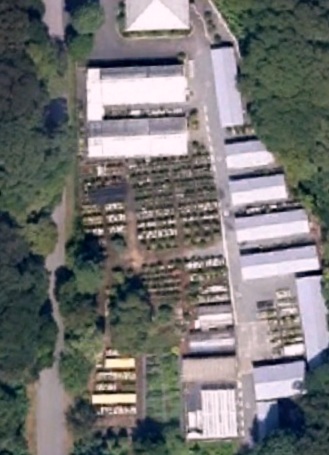
Image captured 09 Sep 2012. Larger color images below, also from Google-Imagery and similarly cropped, showing slight changes in lay-out, landscaping and buildings over the years.) |
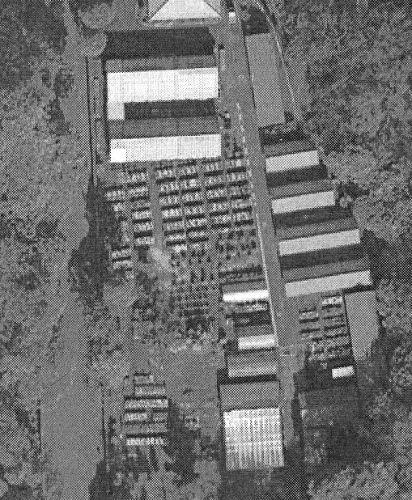
|
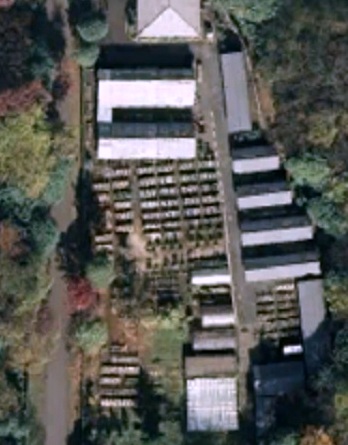
|
|
Image dated 03 Jun 2011 |
Image dated 30 Sep 2009 |
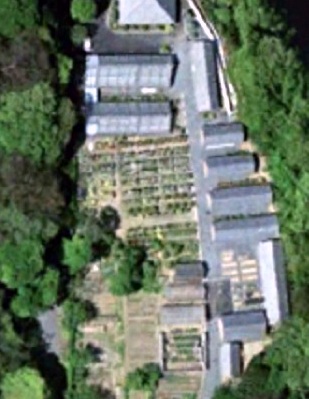
|
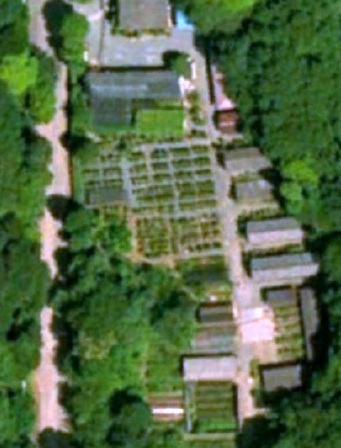
|
|
Image dated 31 Dec 2003 [sic] (NOT Tokyo in winter) Note that a second long greenhouse is now in place near the top of this photo. |
Image dated 31 Dec 1997 [sic] |

|

|
|
Aerial view of the Imperial Bonsai Collection area captured 1979. (http://commons.wikimedia.org/wiki/File:Imperial_place_Japan_1979_air.jpg "Made based on [http://w3land.mlit.go.jp/WebGIS/ National Land Image Information (Color Aerial Photographs)], Ministry of Land, Infrastructure, Transport and Tourism".) |
Aerial view of the Imperial Bonsai Collection area captured 1945-46. (https://www.ww2online.org/image/aerial-view-imperial-palace-tokyo-japan-1945-46 Rotated "Aerial view of the Imperial Palace in Tokyo, Japan, 1945-46".) |
|
In the Imperial Bonsai Collection there are more Japanese red pine (Pinus densiflora, aka-matsu) than Japanese five-needle white pine (Pinus parviflora, goyō-matsu) bonsai. (Although red pine has long been popular, it is a difficult bonsai to create and care for in a container to simulate its original taste and appearance as in nature with its smooth, reddish bark, fine twigs, and the green color of its soft, long needles. Bonsai of five-needle pine -- which imitated the appearance of red pine in nature and had more compact needles -- were created and became popular, instead, as were also naturally tasteful Ezo spruce (Picea glehnii, aka-ezomatsu). The red pine bonsai nearly disappeared outside the Imperial Collection.) 8 One of Japan's National Treasures is the 81 cm (31.9") high and five hundred and fifty-year-old Sandai-Shōgun-no-matsu ("Third generation Tokugawa's pine," var. Negishi, goyo-no-matsu) whose rugged trunk is now hollow. |
|
(Tokyo, A Confidential Guide, 1969, pg. 37 cf. 1981-2010 values in Wikipedia Tokyo article) Except for the Imperial Household Agency headquarters building and the 52-acre East Gardens (Higashi Gyoen), the palace is generally closed to the public. While the Bonsai Collection is not open to the public, over the years a few groups of visiting bonsai enthusiasts from overseas have been allowed private tours of the Ōmichi Bonsai Shitate-ba. The area with its orderly rows of shelves occupies approximately 480 square meters (5,100 sq. ft.). The entire flat ground of the Bonsai Shitate-ba of about 8,000 sq. m. (roughly 2 acres), however, is not limited to bonsai alone but includes the growing of wild plants collected by the late Shōwa Emperor (Hirohito) himself. (On fine, calm days that Emperor would enjoy a stroll in the area and sometimes look in at the Shitate-ba to see how his plants were growing.) Near to where the bonsai are kept, there are greenhouses for tropical plants and orchids, and beds where the flowers of each season are cultivated. Here, too, are the storehouses where countless varieties of bonsai never seen outside the palace are collected and stored and where they rest peacefully with the spirits of the artisans who created them. There are some large-sized bonsai which we don't usually see, and also the dwarf trees in Kōkyo are each kept with their natural character. The caretakers pay special attention not to spoil each tree's character. The Ōmichi Teien Garden has about 600 bonsai pieces of some 90 species of plants. The oldest tree is said to be a 600 year-old shimpaku which the Meiji Emperor bought. The Imperial Bonsai are cared for by the Gardens Section of the Imperial Household Agency's Maintenance and Works Division. 9 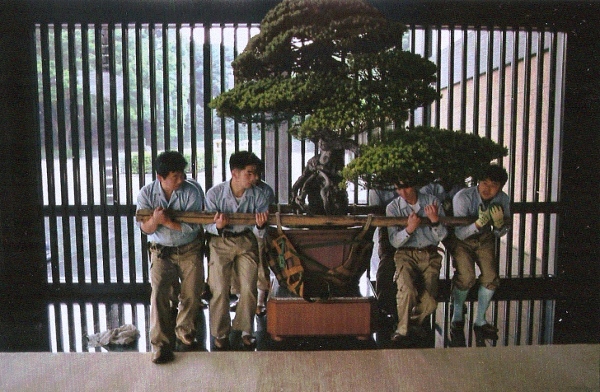
"The years weigh heavy on [eight] imperial gardeners straining to transport a 250-year-old pine.
The bonsai, one of 350 in the Emperor's collection, will greet guests visiting the palace for a state banquet." (Photo by Sam Abell, National Geographic, Jan. 2001, pg. 103) "A network of monofilament lines stretched like a spider's web above Mr. [Fumio] Iizuka's bonsai garden to keep the [jungle] crows [(Corvus macrorhynchos)] from roosting in the plants. Centuries old, these trees had been lovingly tended to maintain their twisted shapes. "'You won't see the outcome of what we're doing to this branch for 20 years,' said Mr. Iizuka, [a mild-mannered man in glasses and shirtsleeves who oversees the Emperor's spectacular bonsai collection] squinting at the raw limb of a red pine. 'You have to be patient in this business.' "As he talked, his hands never stopped picking at needles or leaves, reminding me of a mother absently smoothing her son's cowlick. We paused at the end of a row beside a 400-year-old pine, known as the Crab Tree. 'It was originally shaped like a crab,' said Mr. Iizuka, holding out his arms to demonstrate. 'But, sorry to say, one of the branches died, so now it's a one-armed crab. It was quite a sight in its day,' he said, sighing as if remembering an old love. "Here at the center of the palace grounds, walking among the years of carefully considered garden work, it was easy to forget that we were also at the center of Tokyo. A long-dead bonsai man tended that pine in the days when samurai roamed the land; another, that juniper before Portuguese landed ships at Kyushu; another, that maple when the Emperor was still considered a god. There was a different sense of time here, rooted deep in tradition. Nobody with a Palm Pilot and a production schedule was looking over Mr. Iizuka's shoulder. "'It's hard to find people who appreciate this relaxed approach to things,' he said, stopping beside the garden's oldest resident, a 600-year-old juniper. 'I get a lot of pleasure when our plants are shown at the Emperor's garden party. I feel like they are my children.'" 10 "Morning rain glistens on a venerable maple, one of 350 bonsai in the private gardens of the Imperial Palace. In such potted landscapes mossy rocks suggest mountain ranges, while twisted trees represent those sculpted by wind and weather. "'Unless you love bonsai, you can't work here,' says Fumio Iizuka, [now retired] assistant manager of the Imperial Garden Department. 'You have to be willing to work with them all day long, to figure out when they need water, when they need to be turned toward the sun. Each one has its own aura, to which you need to be attuned. You can't say one is better than another because it is shorter or taller than most. We have many different kinds of trees, just as we have many different kinds of humans. You have to accept each one on its own terms.'" 11 "The Imperial Bonsai are so far beyond the conditions laid down for bonsai in general that the impression they give is one of sheer wonder... Human artifice has been held down to the utmost limit... Grave, stately, preserving nature as it is, with luxuriant foliage yet small branches, all that strikes the eye about a great bonsai is due to the special Palace way of making bonsai, so different from ordinary cultivation. The trees in the Imperial Bonsai Collection have an average age over one hundred years... and trees several hundred years of age are far from rare... steeped in an intensely profound grandeur that cannot be found in just ordinary bonsai." 12 A 380-year old Japanese black pine var. Kashima (Pinus thunbergii var. Kashima, kuromatsu) provided a background for thousands of photographs taken by visitors when the government first placed this bonsai on display at Expo '70. (Kashima in Ibaraki Prefecture is a little ways to the northeast of the Tokyo area. The Ōsaka World Exposition in Senri was the first such exposition to take place in Asia. The theme of Expo '70 was "Progress and Harmony of Mankind." Its special features were the many exhibitions and film and slide presentations about space technology. Seventy-seven countries participated and over sixty-four million visitors attended.) The tree's 135 cm (54") high majestic curved trunk and generally imposing air was definitely at home in a container with the chrysanthemum insignia -- it belongs to the Imperial Family. A considerable number of naturally occurring kuromatsu were discovered at Kashima during the Meiji and Taishō eras, but few survive today. This one is especially valuable for its venerable aspect. It is invariably brought out at the Imperial Palace to mark visits by state guests. 13 In May 1972, from the 14th to 28th, the California Bonsai Society held its 15th Annual Exhibition. This was in conjunction with the 50th Anniversary of the Museum of Science and Technology which sponsors the event. There was a special feature showing of loaned bonsai from the Japanese Imperial Household for this event. 14 The post-war concerted effort to save and restore the Imperial Collection finally made it possible, in 1974, to put the trees on display at a special showing held in Tokyo to mark the golden anniversary of the Emperor and Empress. The display was attended by more than seventy thousand visitors. 15 In March 1975, Japan gave the U.S. a Bicentennial gift of fifty bonsai -- one for each state. Half the miniature trees were donations from private sources, plus three extra from members of the Royal Japanese Family: No. 51 and 52, a Japanese hemlock (Tsuga diversifolia, tsuga) and Trident maple (Acer buergerianum, kaede), respectively, gifts from Princess Chichibu (1909-1995, wife of Hirohito's younger brother) and Prince Takamatsu (1905-1987, Hirohito's second younger brother), while No. 53, is a 126 cm (49-1/2") high one hundred-and-eighty-year-old Japanese red pine in a grey-white glazed round container 84 x 41 cm (33 x 16"). This last tree is the only specimen from the Imperial Household to ever permanently leave Japan. Following a planned quarantine period, the full Collection was finally made available for public viewing at the Bonsai and Penjing Museum at the National Arboretum in Washington, D.C. in July 1976. 16 Meanwhile, back in Tokyo, in April 1976 seventy of the Imperial Collection bonsai were registered as national assets. These particular trees are the ones most lent out for bonsai exhibitions, and those chosen being the ones that are frequently used in the Palace itself. 17 "Indonesian President Gen. Suharto had a personal interest in bonsai and paid a special visit to the Ōmichi garden to view them [on October 2, 1982]." Between April 6 and 9, 1989, the World Bonsai Convention was held at Ōmiya. Its theme was "World Peace Through Bonsai." Over twelve hundred enthusiasts from thirty-two countries gathered for the four-day event at which sixty Japanese masters in total gave demonstrations and workshops. The formal inaugural meeting of the World Bonsai Friendship Federation was held during the Convention. The program also included an exhibition of twenty-three representative trees from the designated group of three hundred trees in the Important Bonsai Masterpieces maintained by the Japanese government as part of the Imperial household. These bonsai represent the highest level of artistic, scientific and historical value and are usually only on display inside the Palace grounds -- not often seen by the general public. The trees are displayed with dignity and grace in valuable antique bonsai containers. They are the work of generations of artists and are truly a national cultural heritage. Kichō ("valuable") bonsai are registered in the list which the Nippon Bonsai Association compiles. Kichō bonsai exist all over Japan. In addition, ten bonsai and ten bonki (bonsai utensils) from the Imperial household were displayed on this occasion. Per Jerry Stowell: "Another bonsai that I remembered from [March] 1967 was a Japanese yew [Taxus cuspidata], multiple trunk style, that our group was privileged to see on the Imperial Palace grounds, where the Imperial Collection is located. This tree had several driftwood, upright trunks that looked more like twigs and sparse foliage in a brick red, unglazed, rectangular, cloud-footed container. The tree did not seem to be worthy of the Imperial Collection. It had little style nor the age of many of the other trees we saw that day. However, I kept these thoughts to myself all these years not expecting to ever see the tree again. To my surprise and delight, it was on display with other trees and containers from the Imperial Household at the World Bonsai Convention. It had matured, was well shaped with a layered effect and now looked like a forest. The main trunk seemed taller and the base had taken on an aged appearance. It seemed worthy of the Imperial Collection." "Then President of France Jacques Chirac visited Japan in [November 18,] 1996. A [large evergreen] bonsai is visible behind him [inside the wide doorway of the south entrance to the Palace] in [official newsreel] footage [as he and Emperor Akihito leave the building]." 18 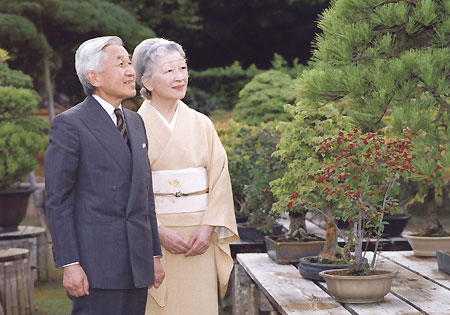
"In this photo released by the Imperial Household Agency,
Japan's Emperor Akihito (L) and Empress Michiko look at a black pine bonsai in the Imperial Palace compound in Tokyo October 3, 2008." "...There is always a representative of the Imperial Bonsai at each Kokufu Bonsai Exhibition. This year [2011, there] was a Japanese black pine. There was also one at the Sakufu Bonsai Exhibitions in December as well. In the past, when Princess Chichibu was around, she always had a bonsai on display, as well as other members of the Imperial family too. This year the Crown Prince came alone, wife ill..." At the Asia-Pacific Bonsai & Suiseki Exhibition and Convention (ASPAC 2011) in Takamatsu from November 18-21, 2011, there were two trees from the Japanese Imperial Garden on display. On April 5, 2017, the Spanish King Felipe VI and his wife Queen Letizia visited the Imperial Palace and a large 380-year-old exposed root 5-needle pine "Neagari Goyo" was on display for them. The 180-year-old "Gansekisho" Japanese black pine tree was shown at the last Kokufu Bonsai Ten exhibition in the Heisei Era (1989-2019) from Feb. 9 to 17. The bonsai, which measures about 120 cm (47") in height and more than 100 cm (40") in width, features deep vertical wrinkles on the surface of its twisted trunks. Emperor Akihito and Empress Michiko have placed this bonsai at "mikurumayose," the doorway for the imperial couple to go out, each Dec. 23, Akihito's birthday, since around 2011. 19 "Both the pots and trays used to contain bonsai are known in the Palace as bonki (bonsai utensils) and there are said to be over three thousand of them. Most of those dating back before the Pacific War used to be kept in the Imperial Household Museum, but when this became the National Museum custody of them was transferred to the Horticultural Division of the then Imperial Household Ministry. Today both bonsai and bonki are taken care of by the Imperial Household Agency's Gardens Section... "There are pots among them that crossed the sea to Japan in ancient days as early imports from China and Nanking porcelain, but the really characteristic features of the Palace bonki can best be seen in the native Japanese pots... produced in every region of the country. No less than twenty-four of these important bonki were registered as national assets in 1973... "In the olden days the more famous artisans did not normally turn their hands to making pots for bonsai, but they would do so if it was on order from or for presentation to the Imperial Household. ...there are pots bearing the Imperial Family crest that are only to be found in the Palace. These were specially commissioned in Okinawa by the bonsai-loving Prince Fushimi for presentation to the Imperial Household in 1908." 20 "At New Year, in accordance with an old tradition, the Private Apartments are decorated with special bonsai creations known as haru-kazari. This tradition has been handed down from the old days, and by the time of the Emperor Kohmei (1844-66), the preparation of these haru-kazari was one of the regular year end events... "To create a haru-kazari, a plum bonsai with either red or white flowers of the type known as kohaku ume was planted in a brocade pattern Imari pot together with special varieties of bamboo and other plants considered to have an auspicious significance, the surface of the soil being then strewn with black Nachiguro pebbles." (Pine, bamboo, and spearflower (Ardisia crispa) were planted with ume for the haru-kazari welcoming 2011.) "On the 30th day of the last month of the year, ...senior members of the government would visit the palace to pay their final respects, and after this had been completed, in the afternoon of the 31st, the New Year haru-kazari were set up simultaneously in the drawing-rooms of Their Imperial Majesties, the Empress Dowager, the Crown Prince, and the princes of the blood. "Some parts of this tradition dating from the beginning of the Meiji Era have now been discontinued. But for haru-kazari today, splendid group plantings of pine, bamboo, and plum (the celebrated "Three Friends of Winter") are created in the Ōmichi Bonsai Shitate-ba just as they were in the old days. In one corner of the bonsai store there is a long row of red and white flowered plum bonsai ranging in height from 170 cm to two meters (67" to 79"). On the 5th or 6th of December the plum trees with their tiny buds still tightly closed are put into the hothouse to begin getting ready for the New Year. Every year before the close of work on December 28th, about forty of these pine, bamboo, and plum groups are prepared by the specialist staff of the Shitate-ba. Only when these have been delivered to the Fukiage Imperial Residence, to the Palace, and to the residences of the princes of blood, can the Bonsai Shitate-ba welcome the New Year." (In 2010 the media was allowed to report the work on 24 December when the work was in the final stage, which then had the haru-kazari set up on 30 December.) 21 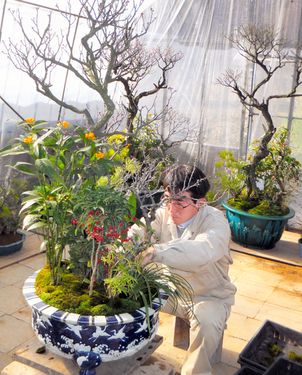
"A gardener of the Imperial Household Agency
arranges a New Year's bonsai pot in the Omichi gardens on the grounds of the Imperial Palace in Tokyo on Dec. 26." (Photo by Ryuichi Kitano, Asahi Shimbun, Dec. 27, 2012) See also these related video clips from Nippon TV News 24: "Imperial Palace Bonsais Get Spruced Up," 12/26/2017, and "Imperial Bonsai Ready for New Year," 01/15/2021. This January 2025 video explores the significance of pine in these decorations. Chotaro (fl. 1898), a bonsai designer and one of the Imperial gardeners; Yukio Itchikawa (fl. 1904), an Imperial gardener; Kyuzo Murata (1931-1991); Yasuji Matsuda (4 years in 1960s when as an apprentice under Murata); Isamu Murata (1991-present); Fumio Iizuka (fl. 2000-2001), assistant manager of the Imperial Garden Department; Masahiko Takeuchi (fl. 2017); Hiroyuki Tsukano (fl. 2017); Toru Suzuki (b.1955) "He maintains bonsai at the Imperial Palace four times a year." 22
"This is the [otherwise unidentified] Bonsai Master and sensei at Showa Park;
at one time he tended the bonsai at the Imperial Palace! Now he's here and also does a show on TV teaching how to create and care for bonsai trees." (Photo from "Showa Kinen Park" entry for Queen B Blog, June 21, 2008) (Showa Park is about 21 miles or 34 km west of the Imperial Palace.) For Additional Information: This 4-minute long slide show, published Jun 27, 2015, of some of the trees in the collection is rather fast-paced, so you might want to be ready to pause to study the trees and read the accompanying passable English text). A slightly longer version without text is described as the Spanish version, published Feb 16, 2017. There is a 2-volume set of video tapes (45-minutes each, in Japanese) showing the bonsai collection. Titled Koukyo no bonsai, it was produced by NHK Video (Japan National Broadcasting Company). Footage includes the facilities, use of bonsai in receptions, bonsai maintenance, an interview with the Garden's director and Saburō Katō, President of the Japan Bonsai Association. The highlight is a group of pictures of the most outstanding specimens in the collection, how they change over the seasons, and samples from the Emperor's collection of bonsai containers. Per http://members.iinet.net.au/~jold/bonsai-in-asia/japan.html and http://buy.id.ebay.com/buying/en/display/180669019341_Bonsai-Video-Japanese-Imperial-Collection-2-volumes. There are also these books: Imperial Bonsai Collection: The Golden Wedding Anniversary Album (1974), 109 pages, in Japanese. The Imperial Bonsai of Japan (1976), 291 pages, in English. Overall title of a particularly interesting section (pp. 275-291) is: "The History of the Imperial Bonsai of Japan." Pages 275-279: "The Imperial Bonsai Trees at the Palace." Pages 280-282: "The Imperial Bonsai Pots & Trays." Pages 283-288: "Bonsai & the Imperial Palace." Pages 289-291: "The Imperial Bonsai Survived Their Wartime Hardships." Scans of these large-format (14.25 x 11.5") text pages were graciously sent to RJB from Alan Walker 8 Jun 2011. For educational purposes, this material has been extensively excerpted in order to more fully present this important story on these pages. The Imperial Bonsai Collection of Japan (1991), 126 pages, in English and Japanese. Thirty-nine illustrated bonsai plus two New Year's displays. The Imperial Bonsai Pots of Japan (1998), 285 pp., in Japanese. The Four Seasons of Bonsai in the Imperial Palace by Midorikawa Yoichi (1998), Toho Shuppan, in Japanese. Bonsai in the Imperial Garden: The enchanting four seasons of the Ohmichi Garden by The Imperial Family Magazine is a 163-page Kindle Book in Japanese from 2021. (Brought to RJB's attention by Gerald Rainville in FB Mesenger, 03/25/23.) "Imperial Bonsai" http://bonsai.shikoku-np.co.jp/imperial/ja/, pictures of 32 trees with Japanese text on 3 pages. Last photo is of Iemitsu's pine. http://bonsai.shikoku-np.co.jp/imperial/en/, pictures of 12 trees with English text. Last photo is of Iemitsu's pine. http://www.flickr.com/photos/45271580@N07/4740437664/in/photostream/, pictures of at least five "Imperial colection [sic] Bonsai," including Iemitsu's. "Tomamo Parc Japan - Imperial Bonsai", Bonsai Focus, 25 pictures including trees and stones. Also, On March 20, 2018 (until April 5), there was a 20 min. 2017 program of NHK World TV available on-line, "Imperial Bonsai: Trees as Cultural Diplomats." Some 500 bonsai masterpieces of some 90 species are mentioned. "Bonsai are a potted incarnation of Japan's nature-loving aesthetic and are globally admired as living works of art. The bonsai in the Imperial Palace also have another very special role to play. When overseas guests visit the Palace, bonsai are displayed as one embodiment of Japanese culture. Great occasions welcoming global visitors." "The usual bonsai practice of training branches with wire is rarely used in the Palace. The emphasis here is on nurturing a specimen's individuality while using as little artificial intervention as possible." The healthy-looking Sandai-Shogun-no-matsu pine is seen between the 7:00 and 8:00 marks. Wonderful close-ups and slow pans mark the video of this program. An estimated 600-year-old twin-trunk juniper 130 cm high is considered to be the oldest tree in the collection. Its shari is greenish in color -- reflecting the Palace's minimal intervention approach to cultivation. Many of the trees are seen tied with fiber to their pots, wooden benches, or low stands. The trees are carefully watered every day, and in the summer may be watered two or even three times daily. The bonki storehouse is also shown, where the Palace's pots not-in-use are carefully stored by type. The building has seismic isolation to prevent earthquake damage. So, now that you've read the detailed story of the Japanese Imperial Bonsai Collection and have an idea about the garden's layout, please enjoy watching this hour-long video in Japanese with Japanese subtitles from 2018 about "The Emperor's Bonsai," the closest we will come to knowing this place short of an actual invitation and guided tour to the Ōmichi Bonsai Shitate-ba. Profiles of about 18 specimens throughout the video (Sandai-Shogun being the third), profiles of several bonki, footage of the aforementioned heads of state visiting the collection, eight-men tree moving, general history of the development of bonsai, animated portrayal of the fire-bombing, etc. make this video a worthy companion to this article and vice-versa. |
|
NOTES 1. Quote from Hill, Warren "Reflections on Japan," NBF Bulletin, Winter 2000, Vol. XI, No. 2, pg. 5, https://www.bonsai-nbf.org/site/images/bulletins/vol11no2.pdf. Mr. Hill was the second curator of the National Bonsai and Penjing Museum in Washington, D.C. from 1996-2001. The Imperial Bonsai of Japan (1976), pp. 275, 283-285. The end of Hill's article is from pg. 287. Also some notes from the Wikipedia article on the "Tokyo Imperial Palace," the Frommers article "Review of East Garden (Higashi Gyoen)," Briggs, Don Tokyo, A Confidential Guide (Tokyo: Don Briggs Productions; 1965, 1966, 1968, 1969. 51st Edition), pp. 114-115, 156, and Trager, James The People's Chronology (New York: Henry Holt and Company; 1992, 1994), pp. 68, 214, 246; review and corrections made by Ms. Harumi Fujino, assistant to Mr. Yoshihiro Nakamizu, in e-mails to RJB 13, 19, 22, and 27 Jun 2011; Peter Ben Facebook post June 24, 2002, partially based on Wikipedia article "Emperor Meiji" in FB Messenger response to RJB question. 2. Hammer, Joshua Yokohama burning: the deadly 1923 earthquake and fire that helped forge the path to World War II (NY: Simon & Shuster, Inc.; 2006), pp. 46, 162, 165; Wikipedia article on 1923 Great Kanto Earthquake; http://www.enotes.com/topic/1923_Great_Kant%C5%8D_earthquake; Board of Tourist Industry Japan, The Official Guide (Tokyo: Japanese Government Railways, 1941), pg. 231, 250-251, 569; review and corrections made by Ms. Harumi Fujino in e-mail to RJB 27 Jun 2011. 3. Tokyo, A Confidential Guide, pp. 46, 114-117; Wikipedia article on "List of Edo Fires"; Wikipedia article on "Great Fire of Meireki"; http://www.myjapanesehanga.com/home/artists/kiyochika-kobayashi-1847-1915-/fire-at-ryogoku-from-hama-cho; Hardy, Quentin "Noah Had It Easier -- He Knew How Long the Rains Would Last," Wall Street Journal, September 3, 1993, pg. 1; "Heat bakes Japan, dries reservoirs," The Arizona Republic, August 4, 1994, pg. B8; The People's Chronology, pg. 991; Wikipedia article on "List of Kyoto Fires"; review and corrections made by Ms. Harumi Fujino in e-mails to RJB 27 Jun and 4 Jul 2011. As with many such historical events, statistics sometimes vary widely depending on the source used -- what we have here is our best attempt at portraying the magnitude of what happened. 4. Per a review by Cheryl Owens of the book The Imperial Bonsai of Japan in the Fall 1977 issue of the Bonsai Journal, American Bonsai Society, pg. 66; The Imperial Bonsai of Japan (1976), pg. 275; a commissioned translation of Japanese subtitles from mark 43:21 to 48:59 of "The Emperor's Bonsai" video (https://www.youtube.com/watch?v=YwvQXyieBPY) into English for RJB by Maki[ko] Koba[yashi] on 03/14/25, results via FB Messenger and email, the Ito's are seen at 48:12 and the show at 48:30 to 48:59. 5. Imperial Bonsai of Japan, 1976, by way of scans from Alan Walker 8 Jun 2011, pp. 275-277 with quote about transporting and uniforms from pg. 278; translation of Shitate-ba per personal e-mail from Chris Cochrane to RJB, 1 Jun 2011; review and corrections made by Ms. Harumi Fujino in e-mail to RJB 11 Jul 2011; Per Emerson, Gertrude and Weil, Elsie "Crowning the Emperor of Japan," Travel (New York), Vol. XXVI, No. March 1916, pg. 15, "Imperial cooks with white caps and aprons sauntered, little groups of Imperial gardeners and weed women, with blue and white towels tied around their heads, stopped to rake up the Imperial scraps from off the immaculate sand of the Palace grounds." Did both the gardeners and "weed women" have the blue and white "towels" or was that only worn by the latter? 6. Nihon Bonsai Kyōkai Bonsai Masterpieces (Nippon Bonsai Taikan, Grand View of Japanese Bonsai and Nature in Four Seasons) (Tokyo: Seibundō Shinkōsha Publishing Co., Ltd.; 1972), The ninety-page English booklet, translated by Yuji Yoshimura and Samuel H. Beach, pg. 70; Nippon Bonsai Association Classic Bonsai of Japan (Tokyo and New York: Kodansha International, 1989), pg. 169, Color Plate 1; Murata, Jin "Brief History of Research Botanical Gardens in Japan - Koishikawa Botanical Garden, Part 2," Foods Food Ingredients Journal of Japan, Vol. 210, No. 7, 2005; Naka, John Yoshio Bonsai Techniques II (Bonsai Institute of California; 1982), pp. 258-260 with six b&w photos; Japan, The Official Guide, pp. 271, 275; Tokyo, A Confidential Guide, pp. 118-119; Wikipedia article on "Bombing of Tokyo"; Wikipedia article on "Tokyo Imperial Palace"; The Imperial Bonsai of Japan (1976), pp. 286-287, 289-291; review and corrections made by Ms. Harumi Fujino in e-mails to RJB 18 Jul and 1 Aug 2011. We can only begin to imagine the ages, types, styles, and histories of all those trees which were lost in the destruction of the Koishikawa Botanical Gardens... Was there a written log of the trees made when the transfer took place, and did it survive the war? Are there any other statements by gardeners of the period as to their activities, particularly involving the bonsai? Another what if we discovered: "20 July 1945: 1 B-29 drops a Pumpkin bomb (bomb with same ballistics as the Fat Man nuclear bomb) through overcast. It was aimed at, but missed, the Imperial Palace." [per Polmar, Norman (2004). The Enola Gay: The B-29 That Dropped the Atomic Bomb on Hiroshima. Potomac Books. pg. 24.] 7. Graves, William "Tokyo -- A Profile of Success," National Geographic, November 1986, pp. 612, 642; update by Ms. Harumi Fujino in e-mail to RJB 3 Oct 2011. 8. Personal e-mail from Chris Cochrane to RJB on 2 Jun 2011 included link to Google Maps for the black-and-white bird's-eye image of Imperial Bonsai Collection, which was captured 3 Jun 2011; Color images per RJB son Andrew's computer magic captured on 30 Jun 2013 and 11 Aug 2015; Nakajima, Tsunekaze "Japanese Red Pine Bonsai," International Bonsai, IBA, 2007/No. 4, pg. 5; Bonsai Masterpieces, English, pp. 50-51. 9. Dimensions from The Imperial Bonsai of Japan (1976), pp. 275-276 per personal e-mail from Chris Cochrane to RJB, 1 Jun 2011; review and corrections made by Ms. Harumi Fujino in e-mail to RJB 3 Oct 2011, who also states that she didn't see "Wooden stands from 40-50 cm (15.75 to 19.7") up to 80 cm (31.5") tall hold up the trees" (per pg. 276 of Imperial Bonsai of Japan) there in a September 2011 visit and that the caretakers did not understand what those stands might have been. Pg. 275 also mentioned that "the oldest tree is said to be a thousand years old"; "About Bonsai at Imperial Palace," http://bonsai.shikoku-np.co.jp/imperial/en/about.html; cf. Kempinski, Robert "Trip to Japan," Bonsai Journal, ABS, Vol. 39, No. 1, Spring 2004, pg. 26, which states that the current Imperial collection contains over 1,000 trees. 10. Poole, Robert M. "Japan's Imperial Palace, Beyond the Moat," National Geographic, Vol. 199, No. 1, January 2001, pp. 104, 108, 111. 11. Morning rain quote is text for "For the Love of Bonsai" photograph by Sam Abell, in Poole, Robert M. "Japan's Imperial Palace," National Geographic, 2001, http://ngm.nationalgeographic.com/ngm/0101/feature5/zoom3.html; review and corrections made by Ms. Harumi Fujino in e-mail to RJB 3 Oct 2011. 12. The Imperial Bonsai of Japan (1976), pp. 278-279. 13. Classic, pg. 169, color plate 2; review and corrections made by Ms. Harumi Fujino in e-mail to RJB 3 Oct 2011. 14. "Bonsai Show Calendar," Bonsai Magazine, BCI, Vol. X, No. 10, December 1971, pg. 4. 15. Classic, pg. 169. 16. Naka, John and Yuji Yoshimura (eds.) The National Bonsai Collection Guidebook (Atlanta, GA: Symmes Systems; 1977), pp. 4, b&w photo pg. 13 of 350-year Japanese white pine, and b&w photos on pp. 9-11 of Imperial Family gift trees and color of Emperor's red pine on cover, pg. 9. 17. The Imperial Bonsai of Japan (1976), pg. 275. 18. ABStracts, ABS, Vol. 17, No. 1, January-February 1989, pg. 1; Mann, Martin "A Bonsai Odyssey -- April 1989," Bonsai Magazine, BCI, Vol. XXVIII, No. 5, September/October 1989, pg. 3; Stowell, Jerald "People, Place, Plants, Revisited," Bonsai Journal, ABS, Vol. 23, No. 3, Fall 1989, pp. 10-11, see Jerry's bio at the Jun 9 entry in our Bonsai Book of Days project; review and corrections made by Ms. Harumi Fujino in e-mail to RJB 20 Nov 2011. Quotes about Gen. Suharto and Pres. Chirac are from the NHK World TV program "Imperial Bonsai: Trees as Cultural Diplomats." 19. Photo from article "Japan's emperor cancels duties due to health worry," China Daily, 2008-12-03; Personal e-mail from William N. Valavanis to RJB 21 Feb 2011, which stated that the Sakufu was in early January. This matches dating in "The Best Bonsai and Suiseki Exhibits in Japan" by Thomas S. Elias, originally found on pg. 12 (of pp. 10-14 article) of the May/June 2002 issue of Bonsai Clubs International's Bonsai Magazine. However, per e-mail from Ms. Harumi Fujino to RJB 20 Nov 2011, the Sakufu-ten takes place in December and is "held by Bonsai Kyodō kumiai (Bonsai cooperative society) which is in Ueno Green Club." Per WNV in e-mail 30 Nov 2011 to RJB to clarify this discrepancy, "For about 30 years it was held in mid-January at the Daimaru Department Store at the Tokyo Station branch. However, they lost their main sponsor so moved the event to the Ueno Green Club. It has been held in early December for the past few years." ASPAC display mention per Internet Bonsai Club forum posting by Rob Kempinski, 20 Nov 2011. King Felipe IV from NHK World TV program "Imperial Bonsai: Trees as Cultural Diplomats." "Imperial family's bonsai to go on display to mark end of Heisei Era" by Yudai Ogata, The Asahi Shimbun, February 7, 2019. 20. The Imperial Bonsai of Japan (1976), pp. 280-281 (There is more information in this book regarding a couple of specific potters and their connection with the Imperial Bonsai Collection.; review and corrections made by Ms. Harumi Fujino in e-mail to RJB 20 Nov 2011, including these notes: 1) that there are about 2000 bonki in Shitate-ba now, 2) that contrary to Imperial Bonsai of Japan's assertion of articles brought by the first Europeans being in the Collection, there aren't European ones among the bonki in Shitate-ba, and 3) that Prince Fushimi was in England from December 1907 to 1910. 21. The Imperial Bonsai of Japan (1976), pp. 285-286; review, corrections, and updates made by Ms. Harumi Fujino in e-mail to RJB 20 Nov 2011. Please be aware that this "Imperial Bonsai Collection" file location is only authorized to be at http://www.magiminiland.org/BigPicture/Imperial.html and http://www.magiminiland.org/BigPicture/Imperial2.html. 22. Lanmen, Janet "Yasuji Matsuda Visits National Bonsai Collection," Bonsai Magazine, BCI, May/June 1985, pg. 20; Poole "Japan's Imperial Palace," pg. 104; Per "Early History, Hakone -- the Early Years," (©2013 Hakone Foundation), "Renowned architect Tsunematsu Shintani was selected to design the Upper 'Moon Viewing' House in 1917 and landscape gardener Naoharu Aihara, born to a family of Imperial gardeners in Koyobashi, Tokyo, designed the gardens. The Lower House was built in 1922." This mirrors a Google snippet from The California Horticultural Journal, 1974, Volumes 35-36, pg. 142, which has "Hakone's Japanese garden, comprising about three - and - one - half acres, was designed by Naoharu Aihara, an immigrant landscape gardener who is said to have come from a family of imperial gardeners in Tokyo. It dates from 1918." Per The East, 2005, Vol. 41, pg. 21, Aihara lived from 1870-1940. Takeuchi and Tsukano are seen in the NHK World TV program "Imperial Bonsai: Trees as Cultural Diplomats." Toru Suzuki, 2024, which states that "Mr. Suzuki is one of two who have been recognized by the Agency for Cultural Affairs Award. He maintains bonsai at the Imperial Palace four times a year." In the Wikipedia article Biota of Tokyo Imperial Palace (accessed 10/10/2014), it is stated that: "In 1921, the plants in the Palace were inventoried and published in Imperial Palace Landscape.[In Japanese language only: Kyujo Fuchi Ko by Yukio Ichikawa] This was the first survey of the plants of the Palace. Surveys continued in 1979 (Fukiage Garden), 1980 (Imperial Palace West Block), 1981 (East Gardens), and in 1987-88 (aquatic organisms in moats and ponds). These reports are not available to the public, but provide precise information about the vegetation, its time-course changes, old historic and giant trees. Further surveys started in 1996. The survey of living organisms was reported in 2006. [Biology Study Group[20018-9]]" It would be interesting to learn if any of the bonsai were included in these surveys. |
|
|
|